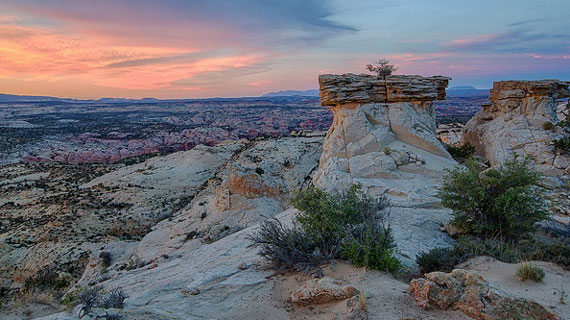Pizza & Politics: University Students Discuss Bears Ears
Posted: December 04, 2017 | Author: Cami Mathews | Read Time: 6 minutes
 The Michael O. Leavitt Center for Politics and Public Service hosts Pizza & Politics every Wednesday at noon to discuss a current political topic. Leavitt Center student employees research the topic and moderate the conversation. These discussions expose students to a variety of important issues and encourages them to share their own perspectives while learning all sides of an issue. Free pizza is provided for all who attend.
The Michael O. Leavitt Center for Politics and Public Service hosts Pizza & Politics every Wednesday at noon to discuss a current political topic. Leavitt Center student employees research the topic and moderate the conversation. These discussions expose students to a variety of important issues and encourages them to share their own perspectives while learning all sides of an issue. Free pizza is provided for all who attend.With a goal to cover issues relevant to students, the Leavitt Center moderated a discussion recently on public lands. The discussion was moderated by Shelese Stoddard, a junior Political Science major from Reno, Nevada, and Ryan Robinson, a senior Political Science major from Parowan, Utah.
The discussion began with a basic understanding of public lands. These are owned and maintained by the federal government for public domain. Public lands include conservation areas, wildlife refuges, historic sites, national parks, and national monuments. The latter two were the main focus of the public lands conversation.
National parks are made up of land that is protected due to the scenic, inspirational, educational, and recreational value. National monuments are land with objects of historical, cultural, and/or scientific interest. The Bureau of Land Management (BLM) controls the most public land with 247.3 million acres, according to the Congressional Research Service. BLM land accommodates various uses as diverse as energy production, recreation, and open space.
Most of the federally owned lands reside in the western part of the United States. Utah has the second-most federally owned land with 64.9%, with Nevada leading the country with 84.9%, most of which is BLM land.
What role, if any, should states have in running national parks or monuments?
It should be noted here that national parks and monuments have a large amount of required upkeep. Many students in the discussion felt that the states should run the parks and monuments, but the government should help financially.
It should be noted here that national parks and monuments have a large amount of required upkeep. Many students in the discussion felt that the states should run the parks and monuments, but the government should help financially.
Though many students agreed with this proposal, others felt that if the state wanted to run the land, they should be in charge of everything, including finances. The group felt that any debt incurred up to this point would still be the federal government’s responsibility, but moving forward it would belong to the state.
What influence, if any, should Presidents have on national monuments?
To preface this question, the moderators educated the audience on the Antiquities Act. This act was passed by Congress in 1906, then signed into law by President Theodore Roosevelt. The act gives presidential authority to declare a national monument in order to protect valuable cultural objects. It states the size of the monument must be the smallest acreage necessary to protect the cultural objects.
To preface this question, the moderators educated the audience on the Antiquities Act. This act was passed by Congress in 1906, then signed into law by President Theodore Roosevelt. The act gives presidential authority to declare a national monument in order to protect valuable cultural objects. It states the size of the monument must be the smallest acreage necessary to protect the cultural objects.
The last bit of information on the Antiquities Act was the main point of concern for students. Many felt that the “smallest acreage necessary” was a rule no longer followed. They felt that Presidents in the past had ignored that part of the act in order to satisfy an agenda or work with only part of the interested groups.
Many did specify that the President should not have a role in designating national monuments, but instead change the process to mirror that of national parks which must have congressional approval. Though state input is often given to the President before a monument is designated, often times the input is thrown aside or comes after a decision has already been made.
Should the National Parks Service increase admission fees at its most popular parks?
This past summer, the National Parks Service announced a proposal to increase entrance fees at 17 of its most popular parks, including Zion, Grand Canyon, and Yellowstone. The fees would only increase during the peak season.
This past summer, the National Parks Service announced a proposal to increase entrance fees at 17 of its most popular parks, including Zion, Grand Canyon, and Yellowstone. The fees would only increase during the peak season.
Fees would increase to $70 per vehicle at each proposed park. The increase would help with an estimated deferred maintenance of $11.3 billion.
The conversation here was split, with many students having experience working or visiting the local national parks. To start, those who were in favor of the fee increase felt that it would help with park upkeep as many areas do not have the resources to keep up with demand. They also felt that the increased fee would limit the amount of visitors, helping to reduce numbers and preserve the parks.
In argument to the above comments, other individuals felt that the decrease in visitors would come from lower income families who would not be able to afford a trip to the parks. They stated the national parks were for scenic, recreational, and educational purposes, which would not be the case if some people didn’t have access to them.
What role should Native American sacred lands have in the designation of public lands?
There has been a lot of media coverage on Utah’s monuments. President Trump announced that he plans to follow Secretary Zinke’s recommendation to shrink Bears Ears and Grand Staircase-Escalante National Monuments. A coalition of environmental groups filed a lawsuit against the President, claiming that the administration is withholding important information from the review of the monuments.
There has been a lot of media coverage on Utah’s monuments. President Trump announced that he plans to follow Secretary Zinke’s recommendation to shrink Bears Ears and Grand Staircase-Escalante National Monuments. A coalition of environmental groups filed a lawsuit against the President, claiming that the administration is withholding important information from the review of the monuments.
When it comes to Native American input for the designation of public lands, everyone in the audience felt that it should be part of the conversation. The differing opinions came when trying to determine how much weight the input should hold. Some felt that it was only part of the conversation, while others felt it should weigh more heavily as they live in the area and are directly affected.
Should Bears Ears National Monument be reduced in size?
As of now, Bears Ears National Monument is 1.35 million acres. It became a national monument on December 16, 2016, designated by President Obama. The area is home to more than 10,000 sacred Native American sites. Both Navajo and Ute people continue to use the land for ceremonial, foraging, and hunting purposes.
As of now, Bears Ears National Monument is 1.35 million acres. It became a national monument on December 16, 2016, designated by President Obama. The area is home to more than 10,000 sacred Native American sites. Both Navajo and Ute people continue to use the land for ceremonial, foraging, and hunting purposes.
Participants were split with this question. One audience member spoke up about a personal experience with the designation. Her family has had livestock on the land in and around Bears Ears for years and when the designation was approved, lost part of that grazing area to the federal government forcing them to shrink the size of their farm. She explained that this hurt their family because they had less property, leading to less income, leading to financial burdens on the family.
Others spoke up in favor of preserving the land for Native American tribes. They explained that no one uses the land more than the Native Americans who have lived in the area far longer than anyone else. They felt that the area was covering exactly what it needed and no more, following the rules of the Antiquities Act.
All in all, the discussion revealed that there are a lot of passionate students who are eager to discuss public lands. Of the presentation created, just over half was covered because of the in-depth comments that came from the audience.
This article was published more than 3 years ago and might contain outdated information or broken links. As a result, its accuracy cannot be guaranteed.
Tags: Outdoor Recreation Blog Outdoors Leavitt SUU Outdoors



